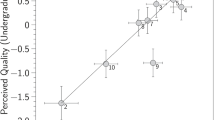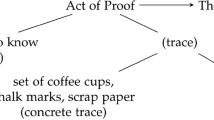Abstract
Understanding that mathematics is founded on reasoning and is not just a collection of rules to apply is an important message to convey to students. Here we examined the reasoning presented in seven topics in nine Australian eighth-grade textbooks. Focusing on explanatory text that introduced new mathematical rules or relationships, we classified explanations according to the mode of reasoning used. Seven modes were identified, making a classification scheme which both refined and extended previous schemes. Most textbooks provided explanations for most topics rather than presenting “rules without reasons” but the main purpose appeared to be rule derivation or justification in preparation for practise exercises, rather than using explanations as thinking tools. Textbooks generally did not distinguish between the legitimacies of deductive and other modes of reasoning.


Similar content being viewed by others
References
Ball, D. (1993). With an eye on the mathematical horizon: dilemmas of teaching elementary school mathematics. The Elementary School Journal, 93(4), 373–397. doi:10.1086/461730.
Blum, W., & Kirsch, A. (1991). Preformal proof: examples and reflections. Educational Studies in Mathematics, 22(2), 183–203. doi:10.1007/BF00555722.
Cabassut, R. (2005). Argumentation and proof in examples taken from French and German textbooks. In M. Bosch (Ed.), Proceedings of the 4th congress of the European Society for Research in Mathematics Education (CERME4) (pp. 391–400). Spain: ERME.
Goswami, U. (2004). Commentary: analogical reasoning and mathematical development. In L. English (Ed.), Mathematical and analogical reasoning of young learners, pp. 169–186. Mahwah, NJ: Lawrence Erlbaum.
Gravemeijer, K., & Stephan, M. (2002). Emergent models as an instructional heuristic. In K. Gravemeijer, R. Lehrer, B. van Oers & L. Verschaffel (Eds.), Symbolizing, modeling and tool use in mathematics education, pp. 145–169. Netherlands: Kluwer.
Hanna, G., & de Bruyn, Y. (1999). Opportunity to learn proof in Ontario grade twelve mathematics texts. Ontario Mathematics Gazette, 37(4), 23–29.
Harel, G., & Sowder, L. (2007). Towards comprehensive perspectives on the learning and teaching of proof. In F. Lester (Ed.), Second handbook of research on mathematics teaching and learning, (pp. 805–842). Reston, VA: National Council of Teachers of Mathematics.
Hiebert, J., Gallimore, R., Garnier, H., Givvin, K. B., Hollingsworth, H., Jacobs, J., et al. (2003). Teaching mathematics in seven countries: results from the TIMSS 1999 Video Study. Washington, DC: National Centre for Education Statistics.
Krippendorff, K. (2004). Content analysis: an introduction to its methodology (2nd ed.). Thousand Oaks, CA: Sage.
Mason, J., & Pimm, D. (1984). Generic examples: seeing the general in the particular. Educational Studies in Mathematics, 15(3), 277–289. doi:10.1007/BF00312078.
Mayer, R. E., Sims, V., & Tajika, H. (1995). A comparison of how textbooks teach mathematical problem solving in Japan and the United States. American Educational Research Journal, 32(2), 443–460.
Nelsen, R. B. (1993). Proofs without words. Washington, DC: Mathematical Association of America.
Nordström, K., & Löfwall, C. (2005). Proof in Swedish upper secondary school mathematics textbooks—the issue of transparency. Proceedings of the 4th congress of the European Society for Research in Mathematics Education (CERME4), pp. 448–457. Spain: ERME.
Pierce, B. (1930). Civic attitudes in American school textbooks. Chicago: University of Chicago Press.
Polya, G. (1954). Mathematics and plausible reasoning. Voluem I: Induction and analogy in mathematics. Princeton, NJ: Princeton University Press.
Sierpinska, A. (1994). Understanding in mathematics. London: Falmer.
Stylianides, G. (2008). Investigating the guidance offered to teachers in curriculum materials: The case of proof in mathematics. International Journal of Science and Mathematics Education, 6(1), 191–215. doi:10.1007/s10763-007-9074-y.
Toulmin, S. E. (1958). The uses of argument. Cambridge: Cambridge University Press.
Watson, A. (2008). School mathematics as a special kind of mathematics. ICMI Symposium on the occasion of the 100th anniversary of ICMI, Working Group 1: Disciplinary Mathematics and School Mathematics, Rome. http://www.unige.ch/math/EnsMath/Rome2008/WG1/Papers/WATSON.pdf (accessed 04/08/08).
Author information
Authors and Affiliations
Corresponding author
Electronic Supplementary Materials
Below is the link to the electronic supplementary material.
Supplementary material
(DOC 107 kb)
Rights and permissions
About this article
Cite this article
Stacey, K., Vincent, J. Modes of reasoning in explanations in Australian eighth-grade mathematics textbooks. Educ Stud Math 72, 271–288 (2009). https://doi.org/10.1007/s10649-009-9193-1
Received:
Accepted:
Published:
Issue Date:
DOI: https://doi.org/10.1007/s10649-009-9193-1




